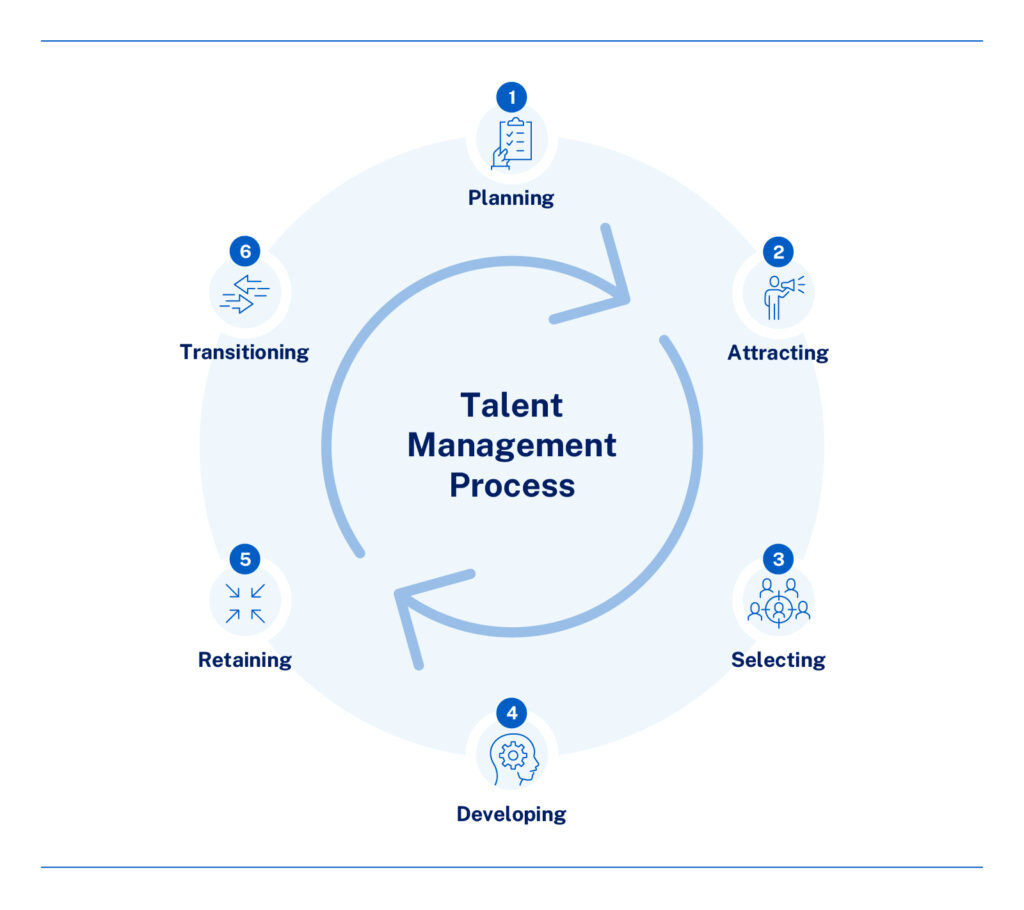Talent management is a critical aspect of modern human resource management, shaping a company’s ability to attract, develop, and retain a high-performing workforce. This talent management strategy isn’t only about hiring new people; it also addresses how organizations develop and support team members throughout their entire employee lifecycle.
Companies aiming to stay competitive need to build a talent-focused culture where human resources are central to achieving long-term business goals.
HR departments focus on building a talent management process that engages and supports team members at every stage, from onboarding and training to performance management and succession planning. Aligning the talent management strategy with organizational goals can boost employee retention, drive productivity, and create an environment where top talent feels valued.
Let’s explore why effective talent management is critical for organizations and how a well-implemented talent management model brings measurable benefits.
Why does talent management matter for organizations?
Implementing a talent management plan aligns an organization’s human capital with its overarching business strategy. When companies focus on developing their people, they’re more likely to see an improvement in productivity, morale, and long-term retention rates. High-performing organizations that prioritize talent management can expect these tangible outcomes:
- Enhanced retention. Effective talent management reduces employee turnover by creating a supportive, motivating environment. By investing in their people, companies foster loyalty and ensure their workforce remains stable.
- Increased productivity. Employee engagement is a direct result of strategic talent initiatives. Engaged employees are more productive and contribute positively to the company’s mission.
- Stronger employer brand. Companies that prioritize talent management also strengthen their employer brand. Platforms like LinkedIn and social media allow companies to showcase their focus on employee growth, which attracts potential employees looking for development opportunities.
Organizations that invest in effective talent management build a work environment where talented employees thrive, making the company a preferred employer and helping reduce skills gaps. As a result, companies can streamline decision-making processes and cultivate a more dynamic, adaptable workforce that supports long-term business success.
Key components of a talent management strategy
An effective talent management strategy integrates various elements that collectively foster a supportive, growth-oriented work environment. Below are the key components that form the backbone of an effective talent management approach:
Talent acquisition and sourcing
Identifying and attracting the right talent is the first step. This includes not only sourcing candidates but also aligning the hiring process with the company’s culture and goals. Talent acquisition teams can leverage referrals, LinkedIn, and other social media channels to find the best talent.
Creating a talent pool of high-potential employees helps ensure the company is always prepared to fill positions with qualified candidates.
Onboarding
The onboarding process is a critical phase in the employee lifecycle that helps new hires adapt to the organization’s culture, understand their roles, and get up to speed. An engaging onboarding experience significantly improves employee retention by making new employees feel welcomed and valued.
Early employee engagement through structured onboarding provides a solid foundation for employee performance and ensures new hires are set up for success.
Talent development and career pathing
To retain and grow high-performing individuals, companies must offer professional development and career paths that encourage skill-building and long-term growth.
Organizations can provide upskilling and development opportunities to address skills gaps and prepare employees for critical roles. Investing in employee growth aligns team competencies with business needs, helping the organization stay competitive.
Performance management
Performance reviews, appraisals, and assessments are essential tools in performance management. They allow managers to evaluate competencies and track progress, aligning individual contributions with business goals. Effective performance management systems help keep team members motivated and focused while fostering a sense of accountability.

What are the benefits of a talent management model?
A robust talent management model benefits both employees and the organization, promoting a more engaged and efficient workforce in the following ways:
- Employee retention. High employee turnover can be costly and disruptive. A strong talent management plan creates a work environment where employees feel valued, leading to increased retention rates. Companies with clear talent strategies are better positioned to keep skilled employees engaged and loyal.
- Enhanced company culture. A talent management strategy reinforces a positive company culture where employees feel they belong. This culture fosters motivation, alignment with organizational goals, and a shared commitment to the company’s mission.
- Placing high-potential employees in critical roles. Identifying and nurturing high-potential individuals ensures the organization has the right people in key roles. This approach fills important positions and empowers employees to grow and contribute at their highest potential.
- Workforce agility. Workforce planning and succession planning help organizations adapt to changes and maintain continuity, even when there’s turnover or new challenges. Organizations can prepare to navigate change by fostering adaptable skill sets.
How to develop a talent management process
A talent management system is essential for organizations aiming to attract, develop, and retain top talent. By centralizing HR processes, this system ensures consistency, improves decision-making, and supports business goals. Below, we explore how to create a talent management system, linking each step to the key stages of the talent management process.
1. Planning: assess organizational needs
Before implementing a talent management system, assess your organization’s current and future needs. Identify skill gaps, workforce trends, and competencies critical for achieving business objectives. Use tools like gap analyses and workforce forecasting to guide your planning efforts.
Example: Conduct interviews with team leaders to identify core skills lacking in current teams and integrate these findings into the system.
2. Attracting: build recruitment and sourcing strategies
Design recruitment processes that resonate with top talent. Utilize sourcing strategies such as employee referrals, job boards, LinkedIn, and social media to reach a wide pool of candidates.
Action Tip: Leverage AI-powered recruitment tools within the talent management system to enhance efficiency and identify high-quality candidates.
3. Selecting: standardize assessments and hiring
A streamlined selection process ensures the best talent aligns with organizational goals. Incorporate consistent assessments and data-driven tools within the talent management system to evaluate candidates objectively.
Metric Example: Track time-to-fill for positions and correlate with new hire performance to optimize the selection phase.
4. Developing: define onboarding and development programs
Onboarding should help new employees feel integrated and empowered from day one. Combine this with structured development programs to nurture long-term engagement and skill growth.
Suggestion: Use the system to track employee progress in training modules and flag individuals for tailored development opportunities.
5. Retaining: establish performance metrics and feedback loops
Retention relies on regular feedback, fair evaluations, and ongoing career development. Implement a performance management module to ensure employees receive clear, constructive reviews.
Key Metric: Monitor turnover rates and engagement scores to understand the effectiveness of retention strategies.
6. Transitioning: plan for succession and workforce development
A robust succession plan minimizes risks of leadership gaps while providing employees with opportunities for advancement. Use the talent management system to map career pathways and forecast future workforce needs.
Pro Tip: Integrate predictive analytics to anticipate talent shortages and plan for critical role transitions.

Measuring a talent management initiative’s success
Tracking talent management initiatives helps organizations assess their effectiveness and make data-driven improvements. Here are some key metrics to monitor:
- Turnover and retention rates. Lower employee turnover and higher retention rates indicate a strong work environment that supports employees. Retaining skilled workers benefits both the company and the team.
- Engagement scores. High employee engagement scores signal that employees feel connected to the organization’s goals and are more likely to stay with the company long-term.
- Performance improvements. Metrics like productivity levels and upskilling progress help measure the success of training and development opportunities. Performance data can guide future decisions and improve the overall talent management model.
Regularly evaluating these metrics helps HR departments adjust their talent strategy to ensure continuous improvement, ultimately supporting the organization’s long-term success.
Embrace talent management for future growth
Prioritizing talent management is one of the most strategic moves an organization can make. With the right talent management strategy, companies can ensure they have the right talent to support business growth and build a strong, resilient workforce.
For leaders looking to strengthen their talent management capabilities, consider IMD’s “Future Leaders” program. It equips leaders with the tools and insights to implement successful talent strategies that drive engagement, growth, and resilience. It’s specially designed for functional experts and managers with at least five years of experience who are ready for greater leadership responsibilities.
The curriculum accelerates participants’ general management journey through three key areas: leading self and others, building business acumen, and developing fresh mindsets through experiential learning in innovation, marketing, finance, and other business domains. It also includes a weekend Alpine experience that helps unlock deep self-awareness, resilience, and adaptability.
Set the foundation for sustainable success and a thriving organizational culture by enrolling today!
Get the latest management content in your inbox 💌
